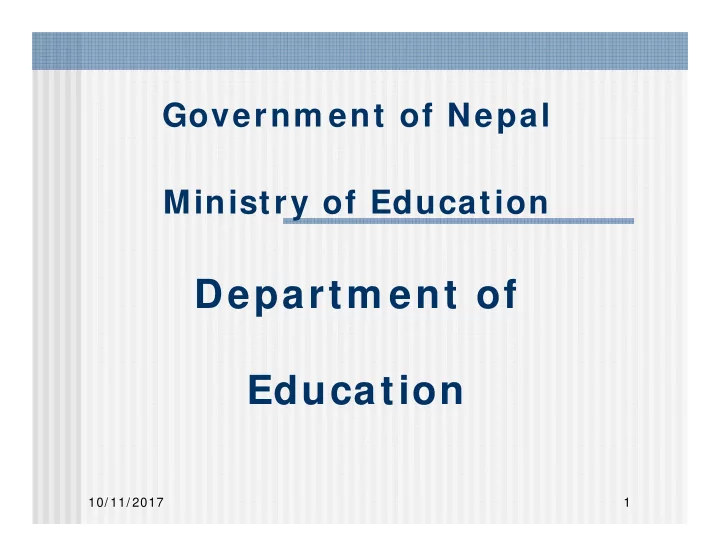

Governm ent of Nepal Ministry of Education Departm ent of Education 10/ 11/ 2017 1
National Education System Structure of Education: Program m e Duration Targeted Coverage Rem arkas groups Early Child hood 1 year 4 years of age Through out development of the country Basic Education 8 years 5-12 years of ,, (5+ 3) age Secondary 4 years 13-16 years of ,, Including TEVET Education (2+ 2) age programme Higher Studies 6 years Graduaters from .. Year and age group is (4+ 2) grade 12 and depend on the Bachelor degree programmes Non-formal Year and age group is Alternative depend on the programme programmes 10/ 11/ 2017 2
National Education Data Production System Foundation of EMI S in Nepal: Rules and regulations, Planning and programme documents (i.e. Monitoring functions, measuring progress against targets, and evaluating the impact of policies and strategies--) Specific TOR by the nature of institutions Different Instructions (CFS/ MECs--) Project and Programme Guidelines 3 10/ 11/ 2017
National Education Data Production System Use of EMI S at different levels of education system : National – broad policy concern DOE – Planning and resource management Regional – Monitoring, Evaluation and Reporting District – Planning and Implementation RC – Management & academic functions School, teachers and parents – operations, transactions and teaching learning process
National Education Data Production System Current practices: I nstitutions that have been m anaged the EMI S under the MOE and others: Organization Information/Database School educational data/information (Flash Department of Education Reporting System) Grade 10, 11 and 12 Examination management National Examination Board (OCE&HSEB) Records National Centre for Education Development Teacher Information (TMIS) Non-Formal Education Data, Community Non-formal Education Centre Mapping TMIS for Permanent teacher working in the Teacher Record Offic (TRO) schools University Grant Commition (UGC) EMIS related to the Higher /Tertiory education Technical and Vocational training council Data/information for TEVT Population, Literacy, Household, Income, Central Bureau of Statistics Economy etc. Save The Children (Community based A few ad-hock and small scalled initiations by Educational Management Information System), INGOs World Education (Student Tracking, Non- Formal Education Data)
Overall process of School Level I EMI S System ( Flash Reporting System ) w ith W eb-based database in Nepal Fill up/ update the District level Police, Planning, Electronic based Flash Reports MOE, Resource School Level Census & Use Line I EMI S by Schools m anagem ent---- m inistries& School School Donors School DoE RC DEOs Send I EMI S School School Flash Reports Softw are Via RC : District National Database Database Flash Reports RC Orientation Data Entry School, VDC/ and Municipality distribution &Districts Report Cards Flash Softw are DEOs ( I m plem ent : District Stakeholders Database ation: Generating Flash I – May 2 0 ( 7 Jestha) electronic I EMI S orientation and distribution---- Flash I I – April 5 ( 2 3 Chaitra) MOE, NPC, GoV/ Non GoV Regional ( REDs) organizations Orientation and Electronic based School level and UI S---- DoE dissem ination Begin I EMI S for School Census
Overall process of School Level I EMI S System ( Flash Reporting System ) in Nepal Initiations to improve in EMIS with reference to SDG4: 660180005 Maha Bouddaha Ma V.xls 10/ 11/ 2017 7
Institutional set up for Monitoring, including SDG4 National level- Committee chaired by PM lead by Monitoring Division at NPC Ministry level- Committee chaired by minister M & E division in Ministry of Education Planning and Monitoring division in Department of Education District and Sub-district level (DEOs&RCs) School Management, PTA at school level Joint review and consultation mission with DPs
Data coverage Based on the mapping of the SDG4 indicators: Almost all the system indicators are covered by the current EMIS There are some indicators, which need additional efforts and system/ sub-system to be established, I.e.: - NFE/ life-long education related indicators TEVET related indicators Health related indicators, and others. sample based periodic HHs, but lack of expected disaggregation of data.
Some Challenges Lack of regular house-hold surveys on OOSC and limited coverage Very limited capacity building on data: Collection: disaggregation Processing: standard mechanism Calculation and analysis: Indicators Adequate financing for the SDG4 monitoring yet to be materialized Collaboration and timely available of information from other agencies. Clarification/ redefine the indicators as per the national context (i.e. Numbers of years free and compulsory primary and secondary education guaranteed in legal frameworks): private schools?
Major Capacity Development Needs Areas to be focused on Capacity Developm ent, Financing and Co-ordination Coverage of data collection: All level and types of data coverage mechanism need to be developed Data production chain (data collection, processing, analysis, and disseminating) Resources (technical, financial and human) Coordination & partnership
Recommend
More recommend